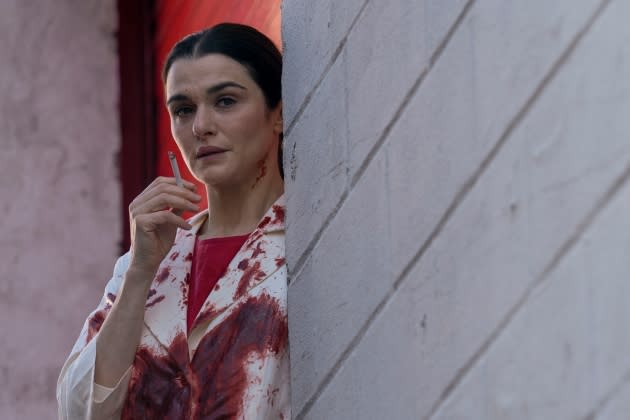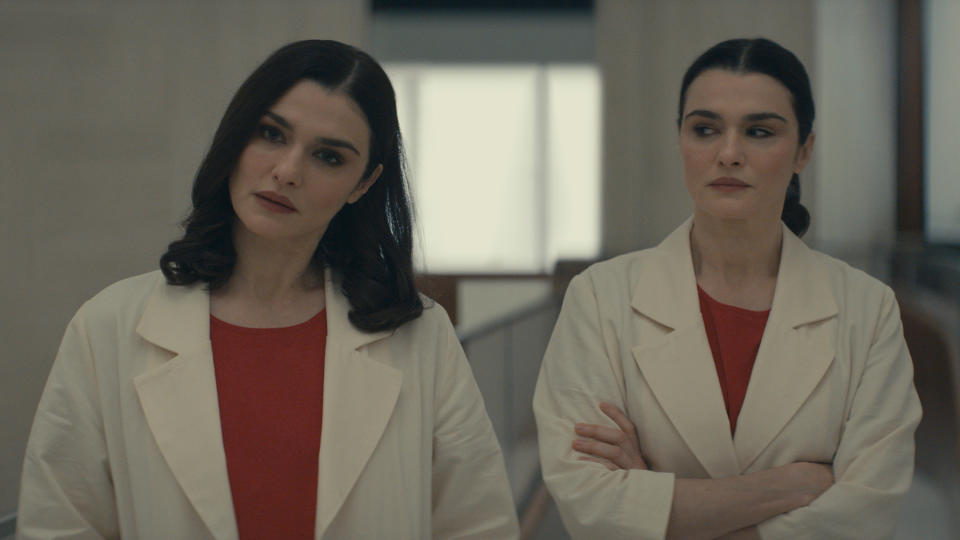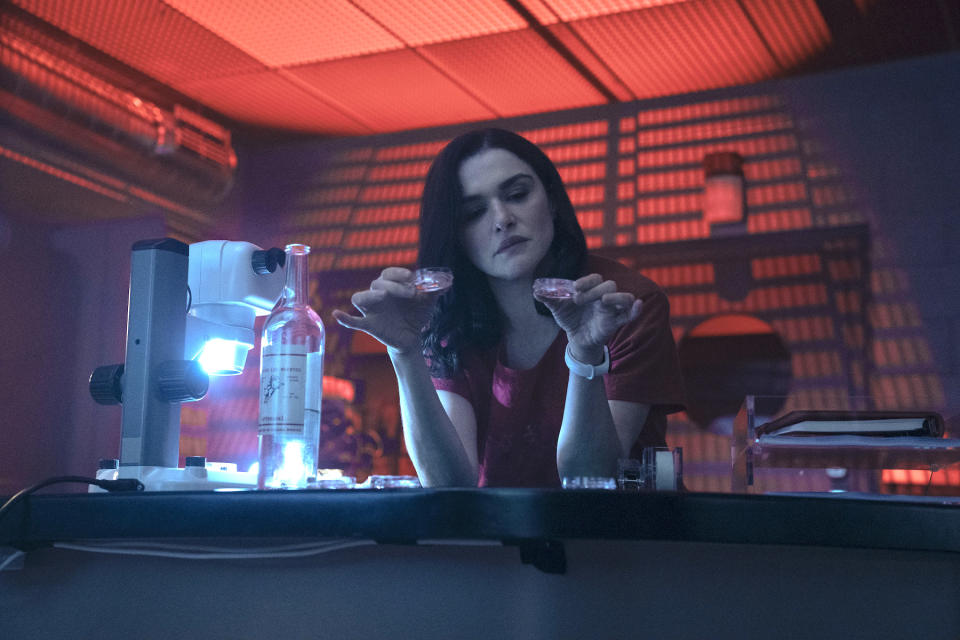Rachel Weisz Doubles Down in ‘Dead Ringers’: ‘It Haunted Me’
- Oops!Something went wrong.Please try again later.
- Oops!Something went wrong.Please try again later.

Once upon a time, there were two real-life identical-twin gynecologists. The brothers worked together at one of the finest hospitals in New York City and were a prominent part of Upper West Side high society. One of them, Cyril, was characterized as slightly more socially awkward than his sibling, Stewart; both were often referred to as “icy,” “aloof,” “remote.” It was rumored that the pair would sometimes switch places during the middle of exams with patients, one pretending to be the other. They would eventually be found together in a filthy apartment, both dead due to withdrawl symptoms from barbituates.
It goes without saying that the media had a field day, and that this stranger-than-fiction tale would inspire a bestselling piece of fiction (Bari Wood and Jack Geasland’s 1977 novel Twins), that would in turn give birth to a movie adaptation. The only unsurprising aspects of all of this is that a) the film eventually ended up in the hands of David Cronenberg, because who else could possibly do this bizarro story justice, and b) it’s a disturbing, unsettling masterpiece. This is where Rachel Weisz comes into the picture.
More from Rolling Stone
The 'Succession' Kill List Contest Could've Been a Lot More Like 'The Hunger Games'
'Succession': The Roy Siblings Meet Their Match in Alexander Skarsgård's Lukas Matsson
Justine Lupe on Willa, the Sex Worker Tied Up in 'Succession'
The Oscar-winning actress doesn’t remember exactly when she saw Cronenberg’s 1988 thriller, but she definitely remembers the feeling of watching it for the first time. “I never forgot it,” Weisz says over Zoom, sitting in front of an odd, slightly-off “picture window view” background that the Canadian filmmaker himself might have designed. “I mean, it haunted me. The movie was just seared into my memory; I must have revisited it again and again over the years.”
Maybe it was the way that Cronenberg turned what could have been mere true-crime tabloid fodder into something, well, Cronenbergesque, with elements of body horror and sublimated kink and a hallucinatory sense of hyperreality. Maybe it was the manner in which Jeremy Irons found a way to channel his late ’80s suavest-reptile-in-the-pit persona across not one but two distinct yet interconnected characters. Or maybe it was just the sheer weirdness of it all, offset by a wickedly perverse sense of humor (“I’ve often thought there should be beauty contests for the insides of bodies… Best Spleen. Most Perfectly Developed Kidneys”) and intellectual musings about identity, sexuality, and biology. Regardless, Dead Ringers had imprinted on her in a big way.
It was five or six years ago, after Weisz had begun taking a bigger step toward becoming involved behind the camera and developing her own projects, that she started thinking about something involving sisters. “I was just looking for material,” she remembers. “It seemed like a good place to start in terms of fertile dramatic terrain, y’know? ‘Codependent dysfunctional siblings who are having a great time, until they’re not.’ That sort of thing. And then very suddenly, it just came to me: What about Dead Ringers? And immediately, it was like, ‘Oh, that would be…’”
Weisz trails off. The notion of turning Elliot and Beverly Mantle — identical twin doctors at their professional heights, respective alpha and beta types whose personal lives are equally (and mutually) self-destructive — from male to female characters may have been born of a desire for an artistic challenge. “It was so I could play both roles, yeah,” Weisz admits. “Nothing more than that at the outset, really. A practical decision.” Yet it’s not the what-if of a famous fan doing a high-concept redo so much as what this idea could be, in terms of a starting point for getting into a host of other things, that truly gets new-fleshed out in her radical, six-part reimagining of Dead Ringers, now streaming on Amazon Prime Video. The gender-flip is key. It also ends up being just the tip of an iceberg that’s razor-sharp from top to bottom.
Weisz had already been mulling this idea over when she took a meeting with Sue Naegle. The former president of HBO Entertainment, Naegle had now moved over to Annapurna Pictures as their Chief Content Officer; she wanted to have an informal discussion about working on something with Weisz. The actor-producer pitched her on a Dead Ringers starring her in dual roles; it would also be something long-form instead of a film, which would allow viewers to get to know the Mantles better and open up their world a bit more. Naegle signed off on the idea and began looking into getting the rights from Morgan Creek Entertainment, who had made the original. While she worked on that, Weisz started looking into writers and possible showrunners.
She remembered Alice Birch’s semi-experimental play Revolt, She Said. Revolt. — “I’d missed seeing it [in 2016], somehow, but ended up reading it and thought it was brilliant” — and how Birch’s voice had stood out to her even on the page. Her screenplay for Lady Macbeth, the screen adaptation of the 19th century Russian play and the movie that introduced international audiences to Weisz’s Black Widow costar Florence Pugh years earlier, had also left an impression on the star. She called Birch while the writer was on a family holiday in Italy. “She had to climb on to a roof to get cell reception,” Weisz says, “so there was an element of danger to our collaboration from the very start.”
Birch listened to the pitch, and as a longtime fan of Weisz, was immediately interested in working on something with her. There was just one issue. “I’d never seen Dead Ringers,” she says, in a separate interview.
“It wasn’t like I’d been avoiding it,” Birch continues. “It was more that I’d somehow missed it. So when I got back, the first thing I did was sit down and watch the Cronenberg movie. And then I watched it again, immediately. It was so strange. But writing two parts for Rachel, not just one — that intrigued me.”

Weisz and Birch met up, first at a pub in London and later in a diner in New York. Noting that they don’t have “proper diners” in England, Weisz said that the restaurant was where she and Birch began imagining what it would be like for the Mantles to be English-born and living in America. (It’s likely not a coincidence that the pilot opens with a scene in a diner.) They began roughly sketching out the Mantle twins’ respective personalities: According to Weisz, Elliot would be hedonistic, vivacious, “always hungry. That was a big thing: She’d love to eat. But she was hungry for everything, in terms of science and experience and men.” Beverly would be the more modest and reticent of the two. “We always imagined her as quiet and queer from the very beginning,” she says.
They knew that someone would come between the two dysfunctional twins, and as in the original, it would be an actress; both Weisz and Birch admired Geneviève Bujold’s performance as the romantic interest of Jeremy Irons’ brothers in the movie so much that they named the psychologically stable girlfriend, played by Britne Oldford, “Genevieve.” They talked loosely about some of the supporting characters as well, including Greta, the sisters’ “maid” with a mysterious agenda of her own. Then Birch went off and assembled a writers’ room that she says only coincidentally ended up being all-female. “They almost all came from a theater background,” Birch says, “and I come from a theater background, so it was more that factor than anything else.”
The gender issue is a slightly thorny one in terms of this Dead Ringers, as it’s neither a gimmick nor the guiding creative factor of the TV show. Birch was quoted early on as saying that switching the Mantles to sisters “changes everything, and changes nothing.” She clarifies: “What I meant by that was, going into this… it was a given that Elliot and Beverly would be female because Rachel would be playing them, obviously. But the idea was never, ‘So now that they’re female, how’s that going to change things? Is that going to make them softer, or stronger, or angrier?’ We never talked about them in those terms.”
“I mean, the fact that we made them obstetricians instead of just gynecologists means that you have female patients coming in and seeing female doctors in that space… and that does alter the dynamic,” she admits. “But it was more important that we see them as being brilliant at their work, messy in their lives, and that the stakes are high for both of them. Everything runs at a faster, more stressful pace for them. The joke was always that Cronenberg’s movie is actually aspirational: The Mantles are running around, martinis in hand, beautiful women on their arm, partying at galas! So we kept thinking of it in those terms. As well as what happens when the fun stops.”

Weisz actually sat in during writers-room pitch meetings, a first for her. She weighed in on ideas, as well as the hiring of department heads and functioning as an executive producer once the show was sold to Amazon. Then, she says, at a certain point, “I told Alice and [producer-director Sean Durkin], ‘OK, I have to go do my other job now.’ The job that didn’t have anything to do with jobs or budgets or scripts. The one that just had to do with acting.” Weisz said she’d lock herself in her office for months as her collaborators worked out preproduction concerns and just pored over Elliott and Beverly’s lines, constructing separate sections in her head for each character.
By the time the star stepped onto a soundstage for the first time, “I had an Elliot and a Beverly… somewhere in there. [Points to head] I couldn’t tell you where. But they were there, and I could access them at will. They were such radically different people. And their relationship to pleasure was so unique. Elliot wants it, even if she gets easily bored. Beverly is scared by it. That helped.”
Weisz would shoot a scene as one Mantle, whether it was a large scene or a smaller one solely against “herself” (British theater actor Kitty Hawthorne would trade off playing the other twin in these sequences, with digital alterations making them appear like Weisz-times-2 exchanges; ironically, Hawthorne also appears as the twin’s mother in a flashback sequence). Then she’d go to hair and make-up, and while she was being transformed into the opposite twin, Birch and the crew would begin setting up new lighting, adjusting everything quickly before Weisz returned. Once she stepped back on the set, everything had been “altered” to let her feel like she’d stepped into a different space altogether. “Even when it was, say, a big dinner party scene,” she says, “everybody would be slightly rearranged and prepared to engage with the ‘other’ twin. Little things like that.”
The result does end up showcasing what’s arguably Weisz’s best performance(s) to date, as well as giving the actor a chance to play across a number of different genres. One of Birch’s central ideas was to make every episode feel like it’s own unique thing even as its moved the story forward, which is why you get outright body horror in the pilot; a particularly cutting, beautifully nasty eat-the-rich satire in Episode Two (you’re reminded that Birch served as a story editor for Succession’s inaugural season); and a Southern Gothic parable in Episode Five, featuring the most symbolically fraught roasted chicken this side of Eraserhead. Images double, then quadruple back, as do in-jokes and references to the Cronenberg film (the show that Genevieve is working on is named Rabid). When Weisz enters a scene, twice, wearing the same red surgical mask and robe-like scrubs as Irons does in the original, the déjà vu is nearly overwhelming.
Yet you never doubt that this new Dead Ringers is, in its own way, an ideal fraternal twin to Cronenberg’s nightmarish story of sibling rivalries and blood bonds. It was important to both Weisz and Birch that they were able to play around in what the latter calls “the tonal world” of the movie, with its swank apartments, aberrant scientific experiments, and slow-burn mental disintegrations. But they also take advantage of both the medical progress that’s happened since the late 1980s, as well as the fact that the politicization of women’s bodies is once again drawing lines in the public mindset. “It’s still relevant,” Birch says, before sighing. “But then again, it’s always tiringly relevant, isn’t it?”
“The fact that women’s bodies are the sites for kind of the battlegrounds for different cultural points, political points of view — it couldn’t not make it into the show by default,” Weisz says. “It gets more and more operatic as it progresses, but the show begins very grounded, so you can buy into the characters in that world and make the case for, you know, well, what’s wrong with maternal health care? Is there anything wrong with it? Here you go in Episode One.”
“So it’s very grounded and believable, I hope,” she says, “and then it can really take off and explore these things that seem kind of scientifically outlandish in that realm… and also is just within arm’s reach. It’s really not sci-fi, it is what we call ‘near-fi.’ Theoretically very possible and almost, you know, right around the corner.”
Best of Rolling Stone

